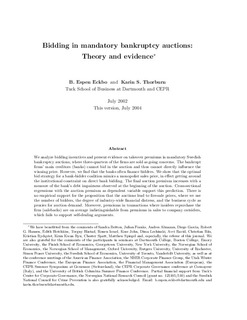| dc.contributor.author | Eckbo, B. Espen | |
| dc.contributor.author | Thorburn, Karin S. | |
| dc.date.accessioned | 2006-07-13T07:34:40Z | |
| dc.date.available | 2006-07-13T07:34:40Z | |
| dc.date.issued | 2004-07 | |
| dc.identifier.issn | 1500-4066 | |
| dc.identifier.uri | http://hdl.handle.net/11250/164161 | |
| dc.description | First issue of this article, July 2002 | en |
| dc.description.abstract | We analyze bidding incentives and present evidence on takeover premiums in mandatory Swedish bankruptcy auctions, where three-quarters of the firms are sold as going concerns. The bankrupt firms’ main creditors (banks) cannot bid in the auction and thus cannot directly influence the winning price. However, we find that the banks often finance bidders. We show that the optimal bid strategy for a bank-bidder coalition mimics a monopolist sales price, in effect getting around the institutional constraint on direct bank bidding. The final auction premium increases with a measure of the bank’s debt impairness observed at the beginning of the auction. Cross-sectional regressions with the auction premium as dependent variable support this prediction. There is no empirical support for the proposition that the auctions lead to fire-sale prices, where we use the number of bidders, the degree of industry-wide financial distress, and the business cycle as proxies for auction demand. Moreover, premiums in transactions where insiders repurchase the firm (salebacks) are on average indistinguishable from premiums in sales to company outsiders, which fails to support self-dealing arguments. | en |
| dc.format.extent | 643686 bytes | |
| dc.format.mimetype | application/pdf | |
| dc.language.iso | eng | en |
| dc.publisher | Norwegian School of Economics and Business Administration. Department of Finance and Management Science | en |
| dc.relation.ispartofseries | Discussion paper | en |
| dc.relation.ispartofseries | 2004:16 | en |
| dc.title | Bidding in mandatory bankruptcy auctions : theory and evidence | en |
| dc.type | Working paper | en |
